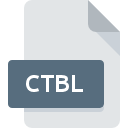.CTBL File Extension

CTB-Locker Ransomware Encrypted File
| Developer | N/A |
| Popularity | |
| Category | Encoded Files |
| Format | .CTBL |
| Cross Platform | Update Soon |
What is an CTBL file?
Files with the .CTBL extension are associated with CTB-Locker ransomware. When this ransomware infects a system, it encrypts files on the affected device and appends the .CTBL extension to them, rendering them inaccessible without the decryption key.
More Information.
CTB-Locker ransomware first appeared in the wild in 2014. Its primary purpose is to encrypt files on a victim’s system and then demand payment in exchange for the decryption key. The ransomware spreads through various vectors, including email attachments, malicious websites, or exploit kits.
Origin Of This File.
The .CTBL extension originates from CTB-Locker, a type of ransomware that emerged around 2014. It’s designed to extort money from victims by encrypting their files and demanding payment for decryption.
File Structure Technical Specification.
The .CTBL extension doesn’t denote a specific file structure or technical specification. Instead, it indicates that the file has been encrypted by CTB-Locker ransomware. The actual file content is encrypted using strong cryptographic algorithms, making it unreadable without the decryption key.
How to Convert the File?
Windows:
- Remove Ransomware: Use reputable antivirus software to scan and remove the CTB-Locker ransomware from your Windows system.
- Decryption Tools: Look for decryption tools specifically designed to decrypt files encrypted by CTB-Locker. These tools may be available from cybersecurity companies or researchers.
- Restore from Backup: If you have backups of your files, restore them from a backup made before the ransomware infection occurred.
Linux:
- Eliminate Ransomware: Utilize antivirus or antimalware software to eradicate the CTB-Locker ransomware from your Linux system.
- Decryption Options: Explore decryption solutions developed for CTB-Locker encrypted files. These may be command-line tools or scripts provided by cybersecurity experts.
- Backup Restoration: If you maintain backups of your data, restore the encrypted files from a backup created prior to the ransomware attack.
MAC:
- Remove the Ransomware: Employ reliable antivirus software to remove the CTB-Locker ransomware from your Mac system.
- Seek Decryption Assistance: Look for decryption tools or solutions specifically designed for decrypting files affected by CTB-Locker ransomware. These tools may be available from reputable cybersecurity firms or researchers.
- Backup Recovery: If you have backups of your files, restore them from a backup that predates the ransomware infection.
Android:
- Disconnect from Network: Disconnect your Android device from any network to prevent further spread of the CTB-Locker ransomware.
- Ransomware Removal: Use antivirus or antimalware apps designed for Android to remove the ransomware from your device.
- File Recovery Options: Explore options for file recovery, such as using reputable decryption tools if available, or restoring encrypted files from backups stored on external devices or cloud services.
iOS:
- Isolate the Device: Disconnect your iOS device from any network to prevent the spread of the CTB-Locker ransomware.
- Antivirus Check: Although iOS is generally more secure, consider using reputable antivirus or security apps to scan for and remove any potential threats.
- Data Recovery: If your iOS device is affected, explore options for data recovery such as restoring from backups made before the ransomware infection occurred.
Others:
- Assess the Situation: Identify the specific platform or device affected by CTB-Locker ransomware.
- Seek Expert Assistance: Consult cybersecurity professionals or online communities for guidance on dealing with the ransomware infection on the particular platform or device.
- Explore Recovery Options: Investigate any available decryption tools, backup restoration methods, or other recovery solutions applicable to the platform or device in question.
Advantages And Disadvantages.
Advantages:
- CTB-Locker ransomware encrypts files securely, making it difficult for victims to recover their data without paying the ransom.
- For cybercriminals, it offers a potentially lucrative revenue stream through ransom payments.
Disadvantages:
- Victims experience loss of access to their important files, leading to potential data loss or operational disruption.
- Paying the ransom doesn’t guarantee that the decryption key will be provided, and there’s no assurance that the encrypted files will be restored even if the ransom is paid.
How to Open CTBL?
Open In Windows
To open .CTBL files in Windows, victims typically need to first remove the ransomware from their system using antivirus software. Once the system is clean, they can attempt to decrypt the files using available decryption tools or by restoring from backup.
Open In Linux
Similarly, .CTBL files can be opened in Linux only after the ransomware has been removed. Users can then explore available decryption options or restore from backups if available.
Open In MAC
Mac users facing .CTBL encrypted files should follow similar steps: remove the ransomware, then attempt decryption using available tools or restore from backups.
Open In Android
Android devices aren’t immune to ransomware attacks. If .CTBL files infect an Android device, users should disconnect it from the network, attempt to remove the ransomware, and then explore options for file recovery or restoration.
Open In IOS
iOS devices are generally more secure against ransomware, but if .CTBL files somehow affect an iOS device, users should disconnect it from any network, remove the ransomware, and then explore recovery options.
Open in Others
For any other platform or device, the process would involve removing the ransomware and then attempting file recovery through decryption tools or backups.













